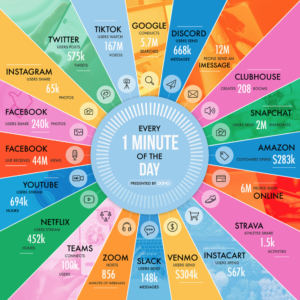Probably, when you hear about curation, the first thing that comes to mind has nothing to do with videos, texts or the internet. The semantic reality is related to something quite different. Thus, the dictionary defines “cure” as to “make an illness, injury or physical damage to a person, animal or organism disappear”. However, the 21st century has given us another meaning for the verb “cure” (and the noun “curation”). It’s a meaning applied to knowledge management. In this article we’re going to explain what “content curation” is and how we can apply this new concept to education.
Not so long ago…
Not so long ago, the content for students was selected, developed and delivered by different publishers whose business involved marketing textbooks. So, at most, the teachers’ task was limited to consulting these books, choosing those that best suited their needs and those of their students and re-adapting and following the guidelines in the teacher’s manual. Today, with the massive irruption of the new technologies into our lives, the story has significantly changed. The amount of information that’s produced almost every second is huge in comparison with the amount produced 20 or 30 years ago. And there are far more formats too. To give you an idea of what this volume means, it’s estimated that five exabytes (trillions of bytes) of information were created between the beginning of writing and 2003. That amount of information is now created every two days. Last year, 5.7 million Google searches were made, 694,000 hours of videos were played on YouTube and 575,000 tweets were posted in a single minute.

This immeasurable ocean of information has its benefits and drawbacks. Its greatest advantage is definitely its accessibility. Never before has it been so easy to access, research and analyse such a wealth of knowledge. What used to take hundreds of hours of searching and research can now be found at the click of a button in just a few seconds. But, as it’s often said, with great power comes a huge degree of responsibility. And producing and consuming content is an extremely important exercise of responsibility that we must learn to perform. It’s at this point that content curation becomes a fundamental tool. How? Let’s take a look.
What’s content curation?
Even if you don’t know what it is, you do it every day. Whenever you go online and search, select and share information with your friends, acquaintances and followers, you perform one of the most rudimentary forms of content curation. Because, to put it very simply, curating content basically consists of searching for, compiling, selecting, organising and sharing information and knowledge and adding value with a specific purpose.
As occurs with so many other resources and processes that have become popular in the information society, this is not new. When we used to go to a library or research centre to look for information in books, scientific journals and newspapers to create a project, we curated content. What’s new is the dimension it has taken on today, with the huge volume of information accessible to us, the speed and ubiquity of the access and the wide range of formats (articles, podcasts, videos, etc.) that we can use to consume knowledge and circulate it.
Content curation in education
As we mentioned above, until only a few years ago knowledge and information were quite limited resources for the teachers and students. Nowadays, the new technologies offer us a limitless array of options beyond the textbook and the library. To make the most of them, digital content curation is the fundamental tool that a teacher must learn to handle, one that brings considerable advantages to the learning process. Scoop.it, the blog specialising in content curation, lists some of them.
Curated content is instantly useful and practical. Unlike the process of searching for the right books and research documents (one which can take hours in the library to find a single major resource), content curation provides immediate access to profound knowledge.
- Curated content emphasises collaborative learning and ongoing conversations. When there’s a centralised online place to find the best content concerning a topic that’s being covered in class, everyone can contribute their thoughts and points of view.
- It’s more dynamic, flexible and adaptable. Curated content can help teachers to keep their examples relevant and updated.
- Content curation enables educators to create and maintain personalised learning centres. These information hubs, jam-packed with relevant and topical examples, help the students to further their understanding of the subject they’re studying at their own pace and in keeping with their needs.
How can we curate content for the classroom?
Content curation goes beyond simply doing a Google search on a topic and adding it. The curation of educational content entails taking into account prior factors. Some tips for curating content for students are listed below:
- Quality over quantity. Quantity doesn’t guarantee the quality of the content. A few well-selected items, depending on our needs and goals, will always be better than a large amount of mediocre content.
- Well-balanced and accessible content in different formats. The content can come in the form of web pages, blog entries, PDF files, news articles, research documents, social media posts, videos and audios. None of it should be neglected if it’s sufficiently valuable. It’s also important to bear in mind whether the content is accessible to all the students.
- It should take into account the learning objectives. The resources that are selected should be related to the learning objectives set by the teacher and provide answers to questions such as “What should the students learn?” “Where do they need additional support?”
- It must be relevant content that’s attractive to the students. It’s very important for the resources that are selected to connect with the tastes and interests of the students, to respond to their experiences and to prove able to capture their attention. It should be content that can help them to contextualise the information and make connections with other topics.
- Involve the students themselves and other colleagues in the curation process. In addition to sharing the task with other professional colleagues in order to benefit from the shared knowledge and work, searching for and selecting content is a basic skill involving a higher degree of thinking that the students need to learn. Therefore, by involving them in the process, they can learn this fundamental skill for their personal and working lives.
- Contribute value. This is one of the most important tasks in the curation. It distinguishes between content curation and the mere gathering of information. Organising it, connecting it, making sense of it and adding our own stamp in accordance with our goals and interests.
Digital content curation is a fundamental competence at a time when the basic material for any 21st-century learner is a computer or any other device connected to the internet. It’s closely linked to informational digital skills and, indirectly, digital creation. Teachers have to incorporate this skill into their pedagogical practice, both to design personalised and contextualised didactics in their environments and to promote high-quality learning among their students, who are also required to learn this competence. The content to be curated increases exponentially every minute that goes by. We should seize the opportunity or we’ll miss out on the “learning train for the 21st century”.






